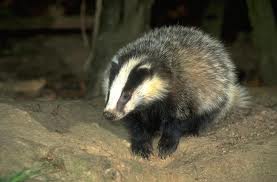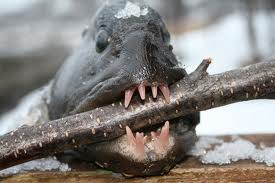Mink
There are two very similar small mammals both collectively known as "minks" (short for mhizitiffivhaunkus - pronounced miz-ee-tizz-ee-zxbu'ui-yhchroiuweoo - meaning "feathered earth whale"), the critically-endangered Iberian flame-tipped selvadorre, and the far more abundant Chilean splatterwhort, which is usually referred to simply as the common mink. From this point on this particular article will focus predominately on the Chilean splatterwhort, which will from now on be referred to as the common mink to make things more easily understood by the more low-brow mink admirers, because the Iberian flame-tipped selvadorre already has an (entirely inaccurate and hopelessly misleading ) article.
Habits, Diet and Natural Habitat[edit]
The common mink, as previously stated, is a small, very uncommon little burrowing mammal similar to a prairie dog or a manatee. It has lush, reddish-purple fur that may grow several feet long and slide greasily across the ground behind it. Their ears are small but are the only habitat of the endangered Venezuelan plague mouse which raises its young deep in the inner sanctum of the mink's brain tissues, feeds upon its nerve fibers and gnaws a hole in it's canal for easy access to the outside world. The venomous and rat-sized wiggly-giggly vaginal flea, also parasitises minks, and while it too lives in the brain it preys mainly on rodents and only rarely does it chew out a few ounces of brain tissue. The mink has only has two rudimentary teeth, and while useless in females they are used by males to bite female's heads and force them to the ground when mating. However, unlike its unimaginably violent relative the
Iberian flame-tipped selvadorre, the regular run-of-the-mill mink does not consume four times its body weight in internal organs daily or tear open the body cavities of orphans to lap up their blood like lemonade with any regularity but instead feeds exclusively on nectar delicately lapped from the blooms of clovers, citruses and honeysuckle. In times of plenty, it also relishes the salty, spiny vegetables of the cucumber vine, the sugar-sweet, bite-sized berries of the lemon tree and the richly flavored seeds of the dandelion. These various herbs only grow abundantly in certain places of the world, so this severely restricts the common mink's range in comparison to its relative, which has a range spanning almost the entire world with the exception of Billings, Montana and Alberta, Canada, where they are illegal as pets and have been virtually eradicated in the wild. The common mink is believed to have evolved to be a voracious carnivore that fed upon small theropods (two-legged dinosaurs like T. rex) in the dinosaur-rich fields of Holland about 15,000 years ago, and being a capable swimmer crossed the Atlantic ocean to reach the eastern coast of North America by the beginning of the ice age 12,000 years ago. There, it began to cry. After it stopped crying, it pooped. Then it cried some more. Finally, empty of poop and dry of tears, and finding itself in a land devoid of the species it had evolved to feed upon but finding itself in a lush, warm climate filled with tropical fruits and flowers, it rapidly adapted to a vegetarian lifestyle and soon lost it's 13-inch venomous fangs and it's wings reverted to mere paws. While it no longer grows 15 feet long and over a ton in weight, the common mink of today still attains an impressive fifteen inches and a weight just over one pound. While it no longer survives in Holland, they still maintain a healthy wild population of individuals (eleven, all male) along the border of Maine and Canada, a single wild female that tenaciously hangs onto life on the island of Manhattan and which is known for her adorable habits of biting children, killing dogs and pooping in drinking fountains, and another population (of forty-eight males) in the confines of Everglades National Park. They are not considered to be of any concern as far as being endangered but are no longer legal to hunt in Georgia. Also, despite the old wive's tail, a mink will drink water if it is thirsty but isn't likely to devour a bowl of sandpaper shreds no matter how thirsty it becomes.
Metamorphosis[edit]
The common mink usually, but not always, passes through four basic life stages - egg, larvae, nymph, and adult ( it's cousin the Iberian flame-tipped selvadorre also passes through these stages but only during leap years). During every July, male mink suddenly go mad and begin to brutally gang rape all females in their vicinity, often killing them in the process. The males hump so much that after several weeks they begin snap their spines and die instantly. After this season's crop of males has passed on, the remaining female animals that survive the onslaught congregate into groups in the upwards of tens of millions. These groups,, called bushnia, will all simultaneously leave their burrows sometime in the early morning hours in mid-December and swim madly across the sea. Being very adept swimmers, it is almost unheard of for even single mink to die during this trip, which would usually take only a few days to complete. As soon as they reached the west coast of Africa, the mink would stop to nibble on some plants, decimating hundreds of square miles of farmer's crops and wild savannah alike, causing countless deaths. The minks would then start running and would keep running until they hit the Namib desert. Here, the exhausted females would lay seven to ten small, pale eggs, each weighing close to a pound in an elaborate burrow which would consist of a shallow scrape in the sand or more often nothing at all. They would then run as fast as they could across the continent, screaming wretchedly all the way, dive into the sea and return to their own burrows in time to enjoy the bounty of the last crop of wild clover blooms of the year. The animals may live upwards of eighty years, and will unwaveringly complete this trip every year they live, except for the many when they won't.
In several days or a few months, depending on climactic conditions, the desert comes alive. Seventy-five million blind, squealing little larval mink begin to hatch from the ground. Breaking their eggshells with a seven-inch bony growth on their snout, all are hatched within thirty seconds of the first one. The foot-long, legless larvae sit on their squishy bodies and squeal helplessly for several days, until they finally stop squealing and squirm into the sea 1,500 miles away. Being poorly adapted for life underwater, the pitiful, air-breathing creatures sink helplessly to the sea floor, where most are eaten by packs of predatory octopi that travel in marauding groups and pick off almost all of the larvae. The few, usually less than ten, that are not eaten lie motionless, until after ten months hunkered down on the sea floor, their eyes open. Still living off of their egg sacs, the frail little creatures crawl pathetically to the southern oceans where they develop into their next life stage, the nymph.
The nymph, which only rarely sings, has fins, hundreds of razor sharp teeth, gills, and a relentless appetite for baby polar tree frogs. Now, polar tree frogs have it hard enough being cold-blooded tree-dwelling bug-eating amphibians in an eternally frozen wasteland completely devoid of plants and insects. However, the nymphs stay hidden in the water by day and by night slither onto the ice and with great rapidity use their mosquito-like sucking mouth parts to drain as many of the weak, very, very cold little frogs as possible of
their bodily fluids before sunrise. A single nymph can kill over 30,000 frogs in the month that it feeds. After this month is over, the nymphs, which now are about 13 inches in length and close to a pound in weight, travel along the coast of Australia, around Africa and straight through the Pacific ocean. Then they travel along the west coast of North America and follow the south American coast up and around until they arrive at the east coast of north America. Here, they metamorphosise and soon are indistinguishable from the adults, except of course for their tiny size. They will mature in a month or two and they will then adopt the herbivorous lifestyles of their elders and lose their ability to fly..
Economical Value[edit]
The common mink is valued for it's lush, pale-mauve pelt which it has for only a month as a young adult that is ideal for almost anything - from pulling from their bodies and lining fancy art-deco ice cube trays with to using them as artificial mauve eyelash extensions. It also is extremely easy to keep alive and breed in captivity so long as natural conditions are simulated exactly. The anti-social, wide-ranging animals are kept in great, wide cages about as big as a breadbox in groups of six and fed their herbivorous natural diet of ground up euthanised dogs, chicken feet and slaughtered horse by-products. The animals breed liberally and lay an egg that weighs 50% more than they do every day for eighty years until they die. However, because of the small spaces not permitting natural back-snapping, males are not killed on their own and as a result have to be manually snapped in half by workers (otherwise they will live for eighty years like the female but also continue growing until they are close to a ton in weight and seven feet tall at the shoulder). Because it's pelt is so useful for so many things, an estimated 25+ billion young mink are slaughtered daily in fur farms in the state of Wisconsin alone. This brings considerable revenue into the state, as each properly harvested pelt sells for nearly 7 cents and even when tax is put in consideration each farmer still manages to just barely break even with how much was spent producing each pelt, unless they don't which is always. However, even when their pelts fail to ring in revenue, the mink's meat - reported to be slimy, fatty, grisly, and putridly musky even when cooked ideally - is considered a delicacy in Canada and the mink's eyeballs are ground into the main ingredient of a popular gelatin brand.





